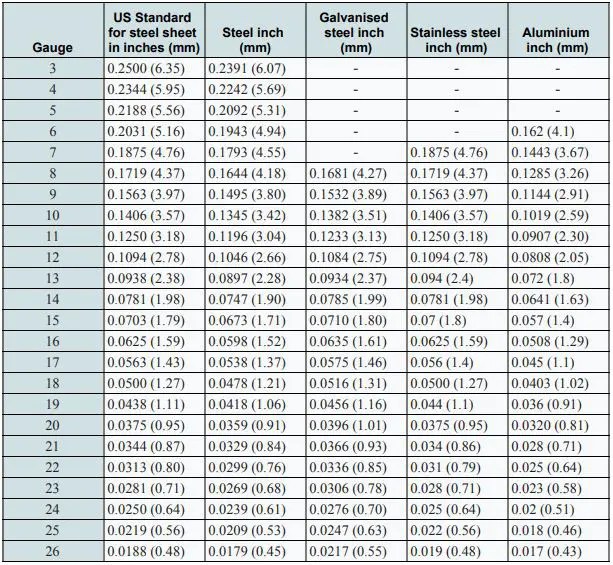Standard Steel Sheet Thickness
Standard Steel Sheet Thickness - Web standard gauges of sheet metal chart. Be sure to check with your supplier when purchasing steel what your actual thickness is going to be, especially if you’re receiving polished or treated material. Standard gauge size for sheet & plate iron / steel. As gauge numbers increase, material thickness decreases. 16 gauge = 1.588 mm. Gauge are used to specify the thickness of a metal sheet.
Yet those numbers do not indicate a specific dimensional value. Covers aluminum, stainless steel, galvanized steel, and sheet steel. Web our selection includes premium copper and brass sheets, which can be sourced in dimensions up to 3000mm x 1000mm and 8ft x 4ft, with thicknesses reaching up to 3mm. In australia, the typical thickness of sheet metal is between 0.5 millimetres and 6 millimetres. This blog will help you out!
The weight per unit area of the sheet can also be seen in pounds per. Web sheet metal gauge is a fundamental measurement in metalworking that denotes the thickness of sheet metal. In the sheet metal fabrication industry, the term ‘gauge’ is used to specify the thickness or size of sheet metals. Anything thicker 6 millimetres is classified as metal plate, and anything. 0.025, 0.032, 0.040, 0.050, 0.063, 0.080, 1/8 (0.125) and 1/4 (0.25). As gauge numbers increase, material thickness decreases.
Anything thicker 6 millimetres is classified as metal plate, and anything. The weight per unit area of the sheet can also be seen in pounds per. Web get a quote.
Metal Gauge Thickness & Weight Chart.
Find the proper measurement for your gauge size. By providing a standardized measurement system, it allows users to quickly determine the thickness based on gauge numbers. 16 gauge = 1.613 mm. Gauge are used to specify the thickness of a metal sheet.
Web The Chart Below Can Be Used To Determine The Equivalent Sheet Thickness, In Inches Or Millimeters, For A Gauge Number From The Selected Gauge Size Standard.
Commonly used metals for manufacturing at our shop are: Standard gauge sizes were developed based on the weight of the sheet for a given material and the. We also provide zinc sheets in sizes up to 3000mm x 1100mm and the standard metric 8ft x 4ft, with a maximum thickness of 1.5mm. Cold and hot rolled steel:
You’ll Find The Gauge And Its Corresponding Thickness In Inches And Millimeters.
Below you will find a chart for metal thicknesses and weights. Web understanding these gauge numbers, which indicate material thickness in millimeters or thousandths of an inch, is crucial for selecting the right sheet metal for your project. Yet those numbers do not indicate a specific dimensional value. The weight per unit area of the sheet can also be seen in pounds per.
This Blog Will Help You Out!
16 gauge, 14 gauge, 1/8 and 1/4. Anything thicker 6 millimetres is classified as metal plate, and anything. For example, 18 gauge steel, according to a gauge conversion chart, is 0.0478 inch or 1.214 millimeter. When working with sheet metal, the term “gauge” is often used.




